What happened to IS in 2023?
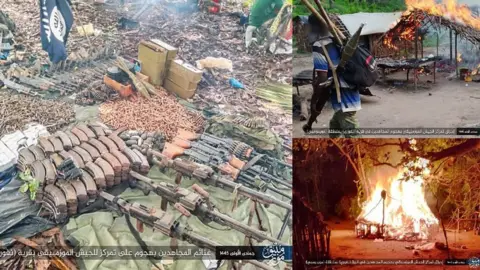 Islamic State Propaganda
Islamic State PropagandaAttacks by the Islamic State (IS) jihadist group, which once held large swathes of territory stretching from north-eastern Syria across western and northern Iraq, showed signs of a significant drop in 2023, according to data collected by BBC Monitoring.
IS claimed a total of 838 attacks globally this year, excluding December, compared to 1,811 for the same period last year, marking a 53% drop.
The analysis and findings on attack figures are based on BBC Monitoring's collection of data from IS' own official claims - as such the figures may be exaggerated or sometimes downplayed - and on IS' official messaging and propaganda, and that of its supporters.
All figures cited for 2023 represent attacks conducted between 1 January and 30 November.
What do we know about IS attacks?
Since the loss of Baghouz - the last stronghold of IS in Syria - in 2019, IS has focused on building up its Africa branches.
The group is still conducting insurgent operations in Iraq and Syria and overseeing networks in Asia, Africa and the Middle East, but a significant drop in their activities has been observed.
IS' Sinai branch claimed no attacks this year, compared to 102 last year, suggesting it suffered a blow by Egypt's armed forces. This was after the group carried out attacks in late 2022, close to the Suez Canal.
The attacks by IS' so-called Khorasan Province branch (ISKP) in Afghanistan also dropped, as the group claimed 20 attacks in 2023, compared to 145 last year and 293 in 2021, the year the Taliban returned to power.
In Iraq, IS claimed a total of 141 attacks in 2023, compared to 401 for the same period last year, marking a 65% drop. In Syria, where IS claimed 112 attacks this year, down from 292 last year.
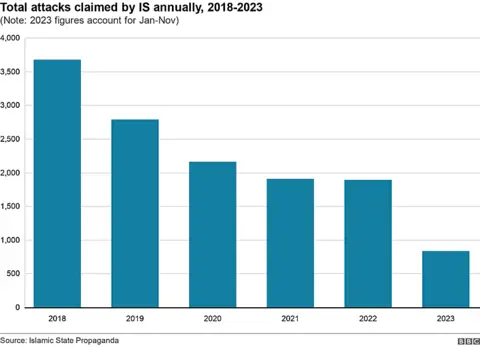
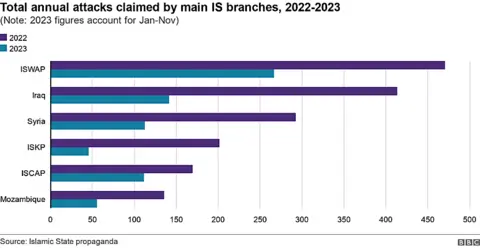
Is IS growing in Africa?
IS has shifted its propaganda to focus on its "expansion" and "victories" in sub-Saharan Africa, where it has five branches: the Nigerian-focused West Africa Province (ISWAP), the DR Congo-focused Central Africa Province, which occasionally makes incursions into Uganda, the Sahel branch, the Mozambique branch and the Somalia branch.
The most active branch was ISWAP, which mostly operates in north-eastern Nigeria and the surrounding Lake Chad region, but in 2023, their activities have dropped too. The group claimed 470 attacks in 2022, and 266 in 2023.
The group's Central Africa Province and Mozambique branches also claimed fewer attacks, although they remained a key threat. Both have continued to claim attacks on local and regional forces as well as against soft targets, namely Christian villagers. IS Central Africa Province claimed four attacks this year in Uganda, but did not claim the deadly June attack on a secondary school in western Uganda, for which it was widely blamed.
Overall, IS-claimed attacks from its sub-Saharan Africa branches combined fell to 508 in 2023, from a total of 847 the year before. However, this still constituted 60% of all IS attacks globally - the largest proportion for Africa to date.
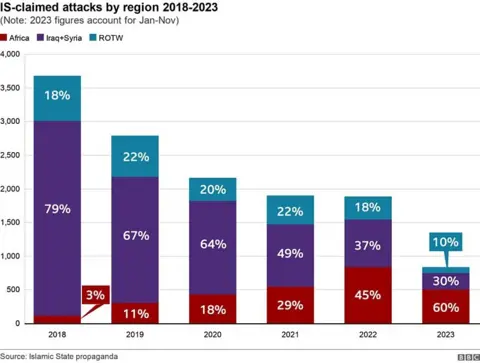
What's happening in the Sahel and the Philippines?
According to data collected by BBC Monitoring, IS' branches in the Sahel region and in the Philippines were more active this year.
IS has been reportedly expanding in eastern Mali near the border with Niger since April, in an apparent attempt to exploit ongoing political and security upheavals affecting the Sahel region.
Following the July coup in Niger, IS claimed a succession of mass-casualty attacks against the army in the west of the country. One attack in early October reportedly killed around 60 soldiers, prompting the Niger government to declare three days of mourning.
Since 2014, IS has been receiving pledges of allegiance from militant groups in South East Asia. The group's affiliates in the region are mostly active in the southern Philippines, where claimed attacks notably increased in the second half of 2023, compared to last year. But it is not high in numbers, seven claimed attacks in 2022, compared to 20 this year.
IS also claimed responsibility for the attack at a catholic Mass in the southern Philippines on 3 December, and issued a call for recruitment in the region.
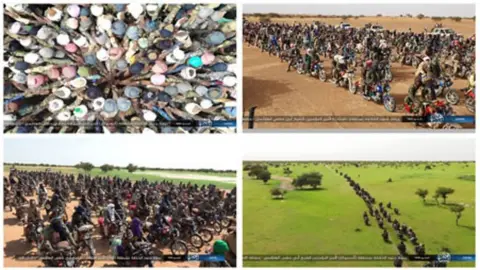 Islamic State Propaganda
Islamic State PropagandaWhat do we know about IS leaders?
The group has suffered heavy losses in its leadership ranks.
IS had three different leaders in just over a year, all killed in Syria between February 2022 and April 2023.
Following the death of Abu Bakr al-Baghdadi in a US raid on 27 October 2019, the group was respectively led by Abu Ibrahim al-Hashimi al-Qurashi, Abu al-Hasan al-Qurashi and Abu al-Hussein al-Qurashi. These leaders are not related. The nom de guerre "al-Qurashi" indicates a link to Prophet Muhammad's tribe of Quraish in Mecca.
In August 2023, IS presented a new leader, Abu Hafs al-Hashimi al-Qurashi, but little is known about him and he is yet to deliver a leadership message.
IS also lost some of its leading commanders, particularly in Syria and Iraq, mostly in US-led coalition strikes.
What's the impact of the war in Gaza?
Military operations against IS and competition from rival groups are believed to be among the contributing factors in the drop of the group's activities. Leadership losses as well as leadership anonymity are also considered to be a major factor.
But IS attack figures are still recorded in the hundreds, especially in Africa, and the group continues to operate in many countries, seeking political, security and communal vulnerabilities to exploit.
The war in Gaza could be seen as one such "opportunity" by IS and other extremist groups, who would seek ways to use the conflict to redirect anger against their enemies.
While al-Qaeda has called on Muslims to take part in the fight alongside Palestinian militants, IS' response featured no praise for Palestinian groups, nor called on Muslims to support Hamas. The group had previously accused Hamas of suppressing its followers in Gaza . Instead, IS focused on inciting revenge attacks worldwide, including against Arab governments whom it accused of "protecting" Israel.
Additional reporting by Paul Brown
